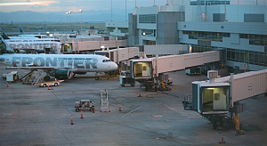Jet bridge
- The word “jetway” is sometimes used for a high-altitude airway -- although the proper term is "jet route."
| Jet bridge | |
|---|---|
 |
|
| Stearns Airport Equipment passenger boarding bridges at Denver International Airport in Denver, Colorado, U.S.A. | |
| Ancestor: | none |
| Related: | Loading bridge, Aerobridge/Airbridge |
| Descendant: | None |
| Carries: | Pedestrians |
| Span range: | 40'-140' |
| Material: | Steel |
| Movable: | Yes |
| Design effort: | Low |
| Falsework required: | No |
A jet bridge (also termed loading bridge, aerobridge/airbridge, jetway, or passenger boarding bridge) is an enclosed, movable connector which extends from an airport terminal gate to an airplane, thereby enabling passengers to board and disembark without having to go outside. It is a type of movable bridge.
Jetway Systems[1] is a registered trademark of JBT Aerotech[2]; however, it is often used in North American parlance to refer generically to any bridge used to board an aircraft, regardless of manufacturer.
This forward-looking invention changed the history of how airports and airlines would handle ground operations for the upcoming years, and had a tremendous impact on airport planning and airport expansion around the world.
Prior to the introduction of jet bridges, passengers would normally board an aircraft by walking along the ground-level tarmac and climbing a set of movable stairs, or by descending airstairs, in aircraft so equipped. Airstairs are rarely used today, but mobile staircases are still employed at many airports around the world, particularly at small regional airports that only service small carriers, and at terminals supporting low cost carriers such as the Low Cost Carrier Terminal at Kuala Lumpur International Airport and the Budget Terminal at Singapore Changi Airport.
Contents |
Advantages
Loading bridges provide all weather dry access to aircraft and enhance the security of terminal operations. They are often permanently attached at one end by a pivot (or rotunda) to the terminal building and have the ability to swing left or right. The cab, located at the end of the loading bridge, may be raised or lowered, extended or retracted, and may pivot, in order to accommodate aircraft of different sizes. These motions are controlled by an operator's station in the cab. The cab is provided with an accordion-like canopy, which allows the bridge to dock with aircraft with differing contours, and provide a nearly weather-proof seal. Additionally, many models offer leveling devices for the portion of the floor that makes contact with the aircraft; this allows passengers to slowly transition from level aircraft floor to sloping jet bridge floor.
Some airports with international gates, such as Taiwan Taoyuan International Airport, Hong Kong International Airport, Amsterdam Schiphol Airport, Kuala Lumpur International Airport, Dubai International Airport, and Incheon International Airport have two bridges for larger aircraft with multiple entrances. In theory, this allows for faster boarding and disembarking of larger aircraft, though it's quite common to use one bridge for only passengers in first class and business class, while the other bridge is only for the use of passengers in economy class. With the arrival of the full double-deck airliners such as the Airbus A380, it is expected that each deck will have one or more loading bridges. Such connectors are being constructed at Kuala Lumpur International Airport and are already in use at Sydney Airport and Singapore Changi Airport with the A380.
Though loading bridges are usually permanently attached at their terminal-building end, leaving only the cab free to move, this is not always the case. Those at Melbourne Airport's international terminal are anchored in the middle and movable at either end – the terminal building-end can be raised or lowered to connect with either the departures level or the arrivals level of the terminal building.
Disadvantages
Loading bridges restrict aircraft parking to spots immediately adjacent to the terminal. Thus, some airports such as Bristol International Airport still use mobile staircases to facilitate boarding at hardstands (remote parking positions). Also, in some cases in winter, the loading bridge may get frozen to the aircraft. In this case, when the Jet Bridge retracts, it could damage the aircraft if that area has not been properly de-iced.
Loading bridges usually cost more to use than remote stands, so many low cost carriers prefer not to use them.
Use and appearance

At the airport terminal, the bridge is connected to a portal (called a "gate") in the terminal wall behind the gate desk. Once airplane boarding starts, passengers hand in their boarding passes to the gate's attendant, who lets them pass through.
Inside, the bridge looks much like a narrow but lighted hallway in an office building, without doors. Loading bridges are constructed without windows The walls are normally painted in accordance with airline standards, generally with relaxing colors. Some bridges have advertisements on interior or exterior walls. Manufacturers also build jet bridges with glass walls.
By using a retractable tunnel design, loading bridges may retract and extend varying lengths. Some airports use fixed walkways to effectively extend the reach of a loading bridge. The fixed walkway extends out from the terminal building and connects to the loading bridge rotunda. Occasionally, fixed bridges lead to multiple loading bridges.
The cab of the loading bridge is raised and lowered in order to dock with aircraft of differing sill heights. The height of the cab is matched to the height of the aircraft door sill height. This often results in a slope along the length of the loading bridge.
References
See also
- Airstair
- Moveable bridge for a list of other movable bridge types
- Covered bridge